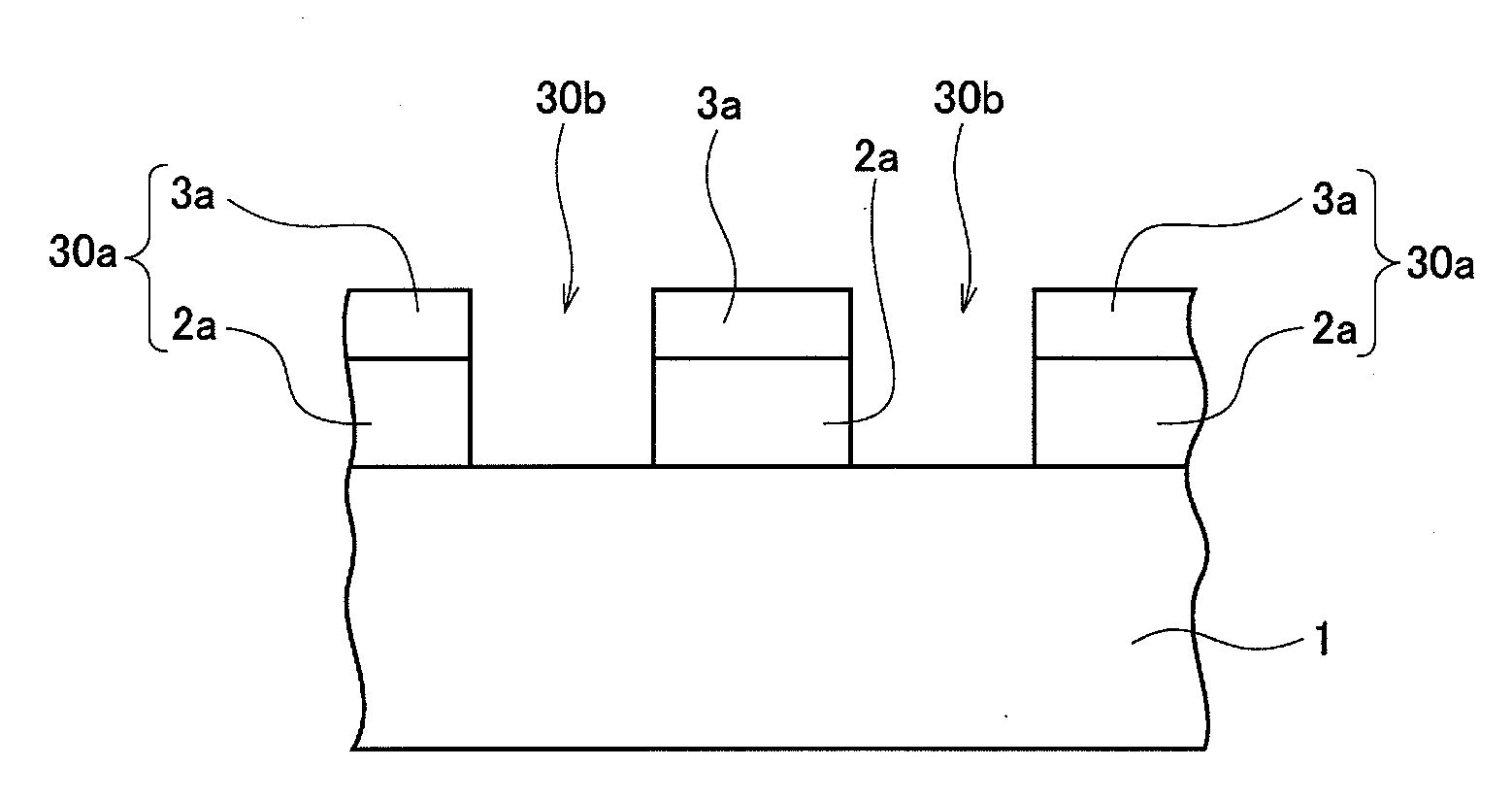Photomask blank, photomask, and photomask manufacturing method
a technology of photomask and manufacturing method, which is applied in the field of photomask blank, photomask, and photomask manufacturing method, can solve the problems of difficult to prevent the collapse of resist pattern, the inability to form satisfactorily desired fine patterns, etc., and achieve the effect of reducing the light-shielding performance or the etching performance of ta metal, improving the smoothness of light-shielding film, and reducing the light-shielding performance of
- Summary
- Abstract
- Description
- Claims
- Application Information
AI Technical Summary
Benefits of technology
Problems solved by technology
Method used
Image
Examples
example 1
[0058]A substrate 1 made of synthetic quartz and having an about 152 mm×152 mm square size with a thickness of 6.35 mm was introduced into a DC magnetron sputtering apparatus. After the inside of the sputtering apparatus was evacuated to 2×10−5 (Pa) or less, a mixed gas (sputtering gas) of Ar and N2 was introduced into the sputtering apparatus. In this event, the flow rate of Ar and the flow rate of N2 were adjusted to 38.5 sccm and 9 sccm, respectively. Ta was used as a sputtering target. After the gas flow rates were stabilized, the power of a DC power supply was set to 1.5 kW, thereby forming a Ta nitride layer 2 having a thickness of 42.4 nm on the substrate 1 (see FIG. 3A).
[0059]Then, while the substrate 1 formed with the Ta nitride layer 2 was maintained in the sputtering apparatus, a mixed gas (sputtering gas) containing an Ar gas at a flow rate of 58 sccm and an O2 gas at a flow rate of 32.5 sccm was introduced into the sputtering apparatus and then the power of the DC power...
example 2
[0065]A photomask blank and a photomask according to Example 2 differ from Example 1 only in specific manufacturing conditions, but are the same in manufacturing sequence and so on. Therefore, specific manufacturing conditions and so on are shown in Table 3 to enable comparison with Example 1 and detailed explanation is omitted.
TABLE 3Introduced Gasduring SputteringConfiguration ofThicknessArN2O2Example 2Material(nm)(sccm)(sccm)(sccm)Front-SurfaceTa—O1358032.5AntireflectionLayerLight-ShieldingTa—N44.230200Layer
[0066]Further, the optical properties and so on of the photomask blank according to Example 2 are collectively shown in Table 4. Defect inspection was conducted using M1350 (trade name) manufactured by Lasertec Corporation and it was confirmed that it was possible to identify defects normally.
TABLE 4Optical PropertiesCompositionSurfaceFront-Back-NORoughnessProperties ofSurfaceSurfaceContentContentRmsExample 2ReflectanceReflectancenkTransmittance(at %)(at %)(nm)Front-Surface19....
example 3
[0067]A photomask blank and a photomask according to Example 3 differ from Examples 1 and 2 only in specific manufacturing conditions, but are the same in manufacturing sequence and so on. Therefore, specific manufacturing conditions and so on are shown in Table 5 to enable comparison with Examples 1 and 2 and detailed explanation is omitted.
TABLE 5Introduced Gasduring SputteringConfiguration ofThicknessArN2O2Example 3Material(nm)(sccm)(sccm)(sccm)Front-SurfaceTa—O1758032.5AntireflectionLayerLight-ShieldingTa—N46.220350Layer
[0068]Further, the optical properties and so on of the photomask blank according to Example 3 are collectively shown in Table 6. Defect inspection was conducted using M1350 (trade name) manufactured by Lasertec Corporation and it was confirmed that it was possible to identify defects normally.
TABLE 6Optical PropertiesCompositionSurfaceFront-Back-NORoughnessProperties ofSurfaceSurfaceContentContentRmsExample 3ReflectanceReflectancenkTransmittance(at %)(at %)(nm)Fr...
PUM
| Property | Measurement | Unit |
|---|---|---|
| thickness | aaaaa | aaaaa |
| thickness | aaaaa | aaaaa |
| thickness | aaaaa | aaaaa |
Abstract
Description
Claims
Application Information
 Login to View More
Login to View More - R&D
- Intellectual Property
- Life Sciences
- Materials
- Tech Scout
- Unparalleled Data Quality
- Higher Quality Content
- 60% Fewer Hallucinations
Browse by: Latest US Patents, China's latest patents, Technical Efficacy Thesaurus, Application Domain, Technology Topic, Popular Technical Reports.
© 2025 PatSnap. All rights reserved.Legal|Privacy policy|Modern Slavery Act Transparency Statement|Sitemap|About US| Contact US: help@patsnap.com



